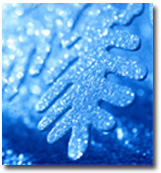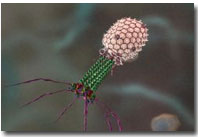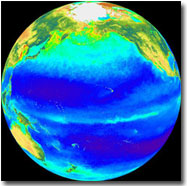 |

|
 |
 |
Detail of a landing snowflake
Credit: Getty Images/PhotoDisc
|
Falloff in Freezes: Study Projects Decrease in Frost Days
Days when the air temperature dips below freezing will become increasingly less common across much of the world by the late 21st century, according to a modeling study by scientists at the National Center for Atmospheric Research in Boulder, Colo. The reduction in days with freezes (frost days) is projected to be most dramatic across the western parts of North America and Europe. The study is the first to examine trends in frost days using a global climate model.
More...
(posted September 1, 2004)
|
 |
|
 |
Periodic dimming of bright starlight reveals distant planet.
Credit: David A. Aguilar, Harvard-Smithsonian Center for Astrophysics
|
Periodic Dimming of Bright Starlight Reveals Distant Planet
Using a network of small telescopes and the "transit method" of detection, scientists
have made their first direct discovery of a planet orbiting a bright star. A
periodic dimming of light from a bright star 500 light-years away revealed the
planet's presence. The star's intense light will allow scientists to explore
the chemical makeup of the planet's atmosphere in future observations. A paper
on the recent discovery appeared online recently in The Astrophysical Journal Letters. "This effort further develops the 'transit method' and lays the groundwork for more research into the composition of the atmospheres surrounding planets outside our solar system," said Cliff Jacobs, program director in NSF's division of atmospheric sciences, which funded the discovery.
More...
(posted September 1, 2004)

|
 |
|
 |
The bacteriophage T4 is preparing to infect its host cell. The structure of bacteriophage T4 is derived from three-dimensional cryo-electron microscopy reconstructions of the baseplate, tail sheath and head capsid, as well as from crystallographic analyses of various phage components. The baseplate and tail proteins are shown in distinct colors.
Credit: Purdue University and Seyet LLC. The animation is based on both recent discoveries and extensive earlier work by a large number of investigators. A full list of contributors is available at the conclusion of the animation.
|
Viruses on the Attack—Revealing visuals show details of a common mechanism for infection
Using a combination of imaging techniques, researchers have determined the mechanics that allow some viruses to invade cells by piercing their outer membranes and digesting their cell walls. The researchers combined their findings with earlier studies to create a near-complete scenario for that form of viral assault. The results have a dual benefit: they show the inner workings of complex, viral nanomachines infecting cells (in a process nearly identical to some viral infections of human cells) and the images provide design tips for engineers hoping to build the gene delivery devices of the future.
More
(posted September 1, 2004)

|
 |
|
 |
In this map of the Pacific Ocean, the deep blue areas are the nutrient-poor and low-fertility central gyres of the major ocean basins. Fewer phytoplankton grow here. The lighter blue areas represent more productive regions with higher rates of nutrient input and consequently higher phytoplankton biomass. The continental shelves and upwelling regions (e.g., along the equator) tend to have higher biomass because of nutrient input.
Credit: Map Courtesy of the National Oceanic and Atmospheric Administration
|
The Power Of One: Unicellular Organisms Contribute More Nitrogen To Ocean Than Reported Earlier, Affect Global Atmosphere
Large, nutrient-poor expanses of the open ocean are getting a substantial nitrogen influx from an abundant group of unicellular organisms that "fix," or chemically alter, nitrogen into a form usable for biological productivity. First identified about five years ago, these organisms – about 7 microns in diameter – are fixing nitrogen at rates up to three times higher than previously reported for the Pacific Ocean, according to research funded by the National Science Foundation (NSF) and published in the Aug. 26, 2004, edition of the journal Nature.
More...
(posted September 1, 2004)

|
 |
| |

|

